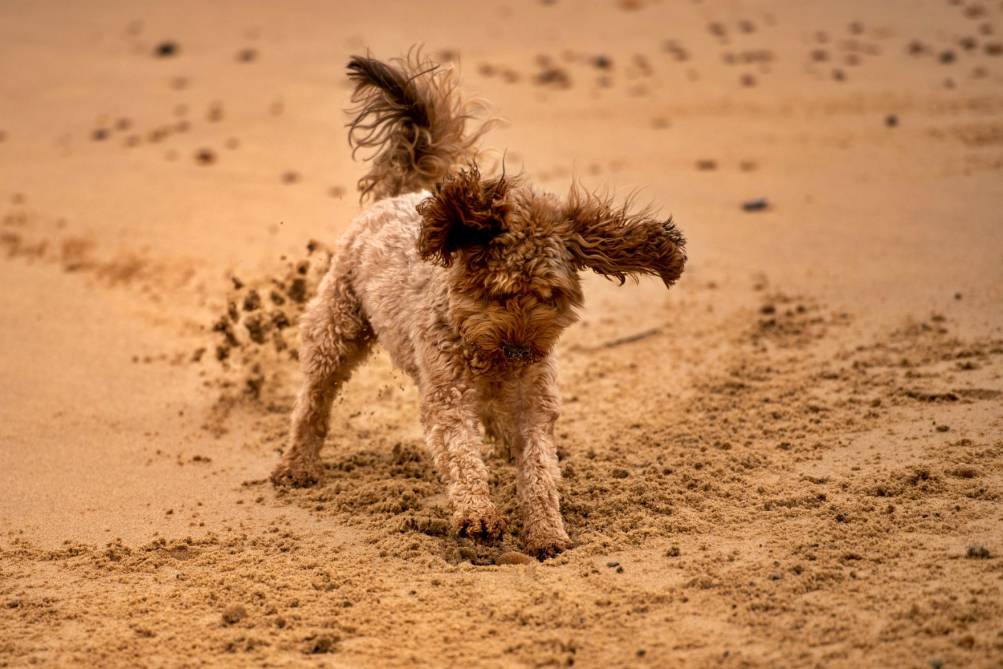
Date: May 3, 2024
Author: Roberto Barata
How to cite: Barata, R. (2024). Vacuum Activity: An Ethological Perspective. Human-Animal Science.
What is Vacuum Activity?
Vacuum activity is a term within the science of ethology that brings to light the instinctual actions of animals without the presence of external stimuli that would generally invoke such behaviors. This is a concept of high theoretical and practical importance in offering animal trainers and behaviorists the necessary insights into the understanding and later management of animal behaviors to effect successful training.
Vacuum activity is the occurrence of innate animal behaviors with the absence of external signals that would typically elicit such responses. This concept reveals that certain behaviors are deeply rooted in an animal’s genetic and neurological framework, showcasing the instinctual nature of these actions.
Vacuum activities are spontaneous, occurring without the external environmental signals that normally trigger these behaviors. They reflect an animal’s intrinsic motivations and internal drives, suggesting that certain patterns are so fundamental that they emerge regardless of situational context.
Examples of Vacuum Activity in Different Animals
-
Domestic Cats: Often seen pouncing or stalking through the house, these behaviors occur even without the presence of a prey animal, driven by their predatory instincts.
-
Predatory Birds: Might execute a striking motion in empty air, simulating catching prey, even when no potential prey is in sight.
-
Horse: Consider a horse that engages in cribbing, where it bites on wood and sucks in air. This behavior can occur without any dietary deficiencies or external stressors traditionally linked to such behavior. The action might stem from an innate need for regular oral stimulation or as a stress response, manifesting even when the usual signals like food scarcity or physical barriers are absent.
-
Dog: A dog might dig holes in the backyard without any buried toys or scents. This behavior can be a display of vacuum activity where the digging is driven by the dog’s instinctual need to create a den or cool resting place, a behavior that would naturally occur in the wild to provide shelter or store food, emerging even when such needs are not evident in a domestic setting.
Principles of Vacuum Activity
This vacuum activity in ethology brings out the basic tenets that tend to broaden the understanding of the instinctive details in animal behavior and the genic forces that provoke the activity. This then points out that the behaviors in question are essentially happening in a vacuum, without the need for extrinsic forces to provoke such a response, portraying the intrinsic genic forces eliciting those behaviors.
-
Innate Behavioral Patterns: Central to vacuum activity is recognizing that certain behaviors are deeply embedded within an animal’s biological makeup. This behavior is hard-wired within the neurological and genetic structures of the animal in question, independent of spontaneous occurrence without external stimuli. This means that these kinds of behavior are not some form of reaction to the prevailing environmental conditions, but rather, they are pre-programmed through evolutionary processes.
-
Internal Motivation and Drive: Such vacuum activities often occur without outside provocation but are due to internal physiological states or motivational drives. If an animal’s internal drives, related to the natural drives of behavior, are blocked by the housing environment, then this internal drive could accumulate and explode into spontaneous expression. The principle puts in place the idea of internal conditions, such as hormonal changes or neurological states, in expressing these behaviors.
-
Genetic and Instinctual Basis: This is the background principle underlying the genetic basis for vacuum activities, in which some instinctual behaviors are genetically coded. The behaviors, therefore, never die but are rather relayed down from one generation to another, with an illustration of their importance of inheritance and their continuity, although the environment the behaviors are found in is not the kind of environment in which these behaviors existed and have their continuity initially.
-
Independence from External Stimuli: This points out that vacuum activities epitomize behaviors that are not easily influenced by the surroundings. These behaviors stand independently, realizing how complex some animal behaviors can be, whereby not all are fostered by external factors but are determinants from intrinsic factors developed over evolutionary timescales.
Is Vacuum Activity A Stereotypic Behavior?
As written above, Vacuum Activity refers to those behaviors that an animal may express without the habitual external stimuli that should elicit it. The concept suggests that the behaviors will be carried out “intrinsically” and that they are done in a “vacuum,” i.e., independently from the usual environmental signals they would normally be attached to.
Stereotypic Behavior, however, embodies repetitive and invariable behaviors that seem to lack a clear goal or function. Such behavior is generally characteristic of animals under conditions of stress or captivity, and they might engage in actions like pacing or even excessive grooming. Generally, the behaviors deemed signs of frustration, environmental stress, or even alterations within the mechanisms of the brain that regulate behavior are actions of stereotypic behaviors. Although both vacuum activity and stereotypic behavior can occur without direct external triggers, it should be noted that the underlying causes of each are fundamentally different. Natural vacuum activities are instinctual behaviors expressed out of their usual context. On the other hand, stereotypic behaviors generally denote that something is wrong with the animal or it is being poorly taken care of; its mental health or animal welfare issues are to be blamed. Therefore, even though they might look the same, vacuum activity is not a stereotypical behavior; rather, it is just a different classification of behavior with its causes and effects. This means that you should analyze the present conditions and individual routines to understand which behaviors are present.
Implications of Vacuum Activity for Animal Trainers: Technical and Scientific Perspectives
All the topics above are important for animal trainers and behaviorists to understand the concept of vacuum activity. It undertakes a view of instinctual animal behaviors that is scientifically sound for training management. Such recognition of vacuum activity will allow them to precognitively manage behaviors that, though outside stimuli, manifested toward the benefit of effectiveness and professional standards for training programs.
Innate Behaviors Anticipation
Animal trainers, on their part, may gain a lot from their knowledge of vacuum activities in their domain, making better predictions and preparing contingencies for the innate behaviors likely to burst out of the blue. This perspective would allow the development of management strategies that consider such behaviors in advance. This reduces the possible stress or conflict during such training sessions. A series of practices, such as environmental adaptation, would be used to properly channel such instinctual actions into avenues that would offer both safety and contentment to the animal.
Differentiation of Behaviors in Training
It is very important to understand the difference between the behaviors produced by external ones and the innate behaviors that are evident in vacuum activities, intending to understand the former’s function. Trainers have to understand that behavior is likely to change by traditional conditioning techniques, and the behavior gets subjected to change as it needs a longer time for change as it is genetic and instinctive. That calls for an appreciation of dual approaches: whereas for the behaviors that are influenced environmentally, conditioning strategies may apply, and management strategies for the inherent ones may, too, seek to allow the same to manifest but in controlled outlets rather than trying to suppress.
Technical Procedures in Training
-
Environmental Adaptation: Includes providing a set of activity settings involving the healthiest and most constructive natural behaviors an animal can perform. For example, this might include the use of specific activities for vacuum species, such as scratching posts for cats or foraging toys for birds that would simulate natural behaviors in hunting and pecking.
-
Structured Training Sessions: Training sessions will be structured to allow the animal to exhibit vacuum activities safely. For example, incorporating scent work exercises for dogs enables owners to harness their pet’s innate tracking abilities. This training method fulfills the dog’s natural desire to sniff and explore and enhances their focus and obedience, providing a productive outlet for their instincts.
-
Observational assessments: Continuous behavioral assessment will help the trainer monitor the frequency and context of vacuum activities. Then, he will assess the level of the animal’s welfare and whether the applied management strategy is appropriate. The assessments should be unbiased, with observation and recording of behavior, and should not in any way influence or change its natural response.
Scientific Perspective on Training Methods Enhanced by Practical Experience
The study of the scientific findings combined with practical experience in animal training provides a good basis for developing effective methods that are sensitive to the needs. Understanding the role vacuum activity plays in this integration is paramount to understanding instinctive behaviors genetically and neurologically ingrained in animals.
Evidence-Based Practices Informed by Real-World Application
The training approaches will be scientifically justified, and the employed techniques will have a scientific base. Therefore, practice applications will be liable to modification according to hands-on experiences and individual animal contexts. This is flexible enough to allow the trainer to use theoretical knowledge in a practically effective way to solve the nuanced challenges presented in such scenarios.
-
Training and Continuous Adaptation: Effective animal trainers are trained to learn and adapt their methods continuously in the light of new scientific knowledge. They perfect the approach with results from their original observation and experiences in day-to-day interactions. This continuous learning loop—from science to practice and back—ensures it is always up-to-date and practical.
-
Integrating Observational Data: Grounded experience presents a wealth of data that can sometimes be integrative or disruptive relative to scientific understanding. An example might be noticing in this practical setting that some vacuum activities were more prevalent or stated differently than the scientific literature would say. This could lead to research that would set deep investigations into animal behavioral studies. Practical training experience requires a lot of prioritization, and although the basic principles of animal behavior do emerge from scientific research, this applied knowledge must go hand in hand with practical experience so that it can well and truly apply to individual cases. Thus, the expression of vacuum activities and their responsiveness to training largely lay under the influence of personality, history, and the environment of the individual animal.
-
Customization of Training Programs: It explains that the way a dog is going to be trained must depend on the kind of animal, its behavior, and the first-hand experience of the trainer on that animal and its environment. What works in a controlled experiment may have to be modified to work as successfully in a diverse, dynamic, real-world environment.
-
Empirical Adjustments: By empirical adjustments, it means that practical experience empowers the trainers to make certain adjustments that might be effective based not necessarily on the full scope supported by ‘scientific literature’ but rather being effective based on the observational outcomes. These are often critical for improving immediate behavioral issues or enhancing animal welfare.
-
Welfare-Oriented Approaches: Training techniques should try not to worsen or at least not reduce the animal’s life level. In this regard, experience has been playing, and is playing, a key role in finding the most effective and, at the same time, professional methods of training, bearing in mind the welfare of the animal.
-
Feedback loops: Real-world experiences and their feedback build into the training protocols, perfecting the methods and inculcating what the animals really need. This feedback is important for ethical consideration because it constantly checks and balances training practices to be in the animals’ best interest.
Conclusion
The vacuum activity is not a mere theoretical construct but a necessary analysis to address and manage their behaviors directly. It all encourages a better appreciation of animal behavior, improvement of training practices with a view to welfare, and encouragement in animal care to a respectful, empathetic attitude. As my understanding of the behavior of other animals develops, so the insights outlined by vacuum activity will continue to outline approaches to training that truly enrich the lives of the animals in our care. This continuous study, applying ethological principles to vacuum activity, allows us to understand the complex requirements of different animal species, helping us serve these species and offer them better facilities and care in their captivity and the wild.
References
Barata, R. (2024) Anthrozoology & Animal Training, 2nd Edition. Human-Animal Science.
Immelmann, K. (1980). Introduction to Ethology. Plenum Press.
McFarland, D. (2006). A Dictionary of Animal Behaviour. Oxford University Press.

